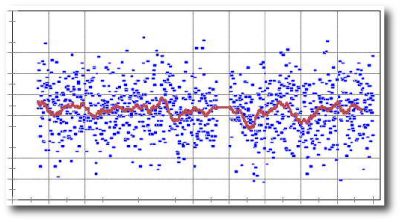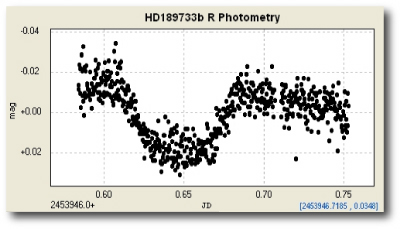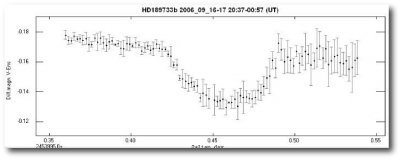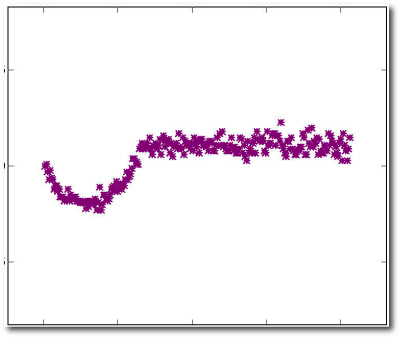
Image Source.
As we work to get the systemic collaboration off the ground, I’ve been letting transitsearch.org coast along on basically its own devices. That will change fairly soon as we incorporate the transitsearch.org site into the oklo.org backend. This will allow for (among other things) creation of transit ephemeris based on submitted fits, and a tighter collaboration among observers.
In the interim, there’s an important opportunity coming up on October 20th, 2006 for transitsearch.org observers to see whether the highly eccentric planet HD 20782 b can be observed in transit. The a-priori probability is 3.6% that we’ll make a huge (and I mean big deal) discovery. Here’s a link to the oklo post from last April describing the system. I’ll be sending out a campaign notice to the transitsearch.org e-mail list shortly, and I’m hoping that AAVSO will want to collaborate on this campaign as well.
A large number of amateur and small-telescope observers have been catching transits recently. Here’s an overview of some of the results that have showed up in my in-box over the past two months:
Last year, transitsearch.org got an important opportunity to follow up on a high-probability transit candidate. The target was the P=3.34 d planet in the close triple star system HD 188753 that was announced by Konacki, 2005 and which received quite a bit of notice in the press.
Konacki’s planet, which has a minimum mass of 1.14 Jupiter masses, and a predicted radius of ~1.1 Jupiter radii, orbits a 1.06 solar-mass star (HD 188753A) at a distance of ~0.05 AU. The star A is in turn separated by 12 AU (e=0.50) from a binary pair (HD 188753B “a” and HD 188753B “b”). The binary pair B consists of stellar components with 0.7 and 0.9 solar masses in a 155-day e=0.1 orbit (separation of 0.67 AU). The presence of a hot Jupiter orbiting HD 188753A was very surprising, because the presence of the binary B leads to severe difficulties for conventional planet formation theories.
Observations in 2005 by Ron Bissinger and other transitsearch.org observers indicated that it is very unlikely that HD 188753A “b” is transiting (the a-priori probability was 11.8%). Further confirmation of a lack of transits came this July from Joe Garlitz of Elgin Oregon, who writes:
Attached is a chart made from data on HD 188753 taken from 04:45 to 09:30 July 21 [UT]. There is no suggestion of a transit during this time within the capacity of this data. It is difficult to get a good data set since there are no stars within the field at a magnitude similar to HD 188753.

Garlitz’s full figure is here, and his website is here.
One disadvantage of having 200-odd planets rattling around in the planet catalog, is that it’s getting hard to keep all the HD numbers straight. HD 188753 doesn’t show transits, but HD189733 most dramatically does. On July 30th, Donn Starkey, of Auburn, Indiana sent a nice light curve of HD 189733 during the JD 2453946.7 transit:

More detail regarding Starkey’s results can be found on his website.
On August 27th, I received a dispatch from Veli-Pekka Hentunen of Varkaus Finland. Summer has finally wrapped up in Finland, and Taurus Hill observatory (featured in this post from last May) is again open for business:
Last weekend, we began to continue exoplanet transit observing after the long Finnish light summer. On the night of August 26-27 w observed our first XO-1b transit at the Taurus Hill Observatory, Varkaus (obs. code A95). We were able to catch only about half of the entire transit because the object was quite low in the north-western sky, and the altitude decreased from 30 to 15 degrees during the course of observation. Our light curves and observing information are given on our English website.
In a follow-up e-mail on September 17th, Hentunen reported that they had observed a full transit for HD 189733 on the night of September 16th-17th:

Starting on September 9th, Tonny Vanmunster, Kent Richardson, and Ron Bissinger all reported observations of the newly discovered TrES-2 transit. Tonny and Kent’s observatons are detailed in this oklo post, whereas Ron’s TrES-2 light curve looks like this:

Don Carona at Texas A&M also sent a light curve of a TrES-2 transit, obtained (under less-than-ideal weather conditions) from the Physics Dept. at College Station. Here’s an unbinned excerpt from his reduced high-cadence time series:

Notice the the lack of a flat bottom for the TrES-2 transit (which is more obvious to the eye when the data is binned). TrES-2 crosses the star with a high “impact parameter”, which means that the planet does not occult the central portion of the star as seen from Earth. Stellar Limb Darkening is responsible for the remarkable smoothness of the dip.
On September 19th, Bob Buchheim of Altimira Observatory sent a very nice HD 189733 lightcurve:

Along with the photometry, he sent a report of an entirely new strain of transit fever:
Last night I monitored HD189733 for a photometric transit signature. A bit of an embarassing story: I noticed that it was nicely placed and “in window”, so I set up the telescope and went to bed … but I forgot to check if transits had already been detected for this star. Imagine my surprise at the resulting deep transit signature! (See attached graph). Oh, well, now that I’ve checked, I see that I’m a year late with this “discovery”.
Bob’s experience reminds me that I’ve got to update the various results pages for the transiting candidates. The transitsearch results page for HD 189733 b reports (erroneously, and by default) that “No photometric transitsearch has yet been reported for this system”. Yikes!
Finally, just a few minutes ago, I got an e-mail from Arto Oksanen, who was the first amateur to observe an HD 209458b transit (on Sept. 16th, 2000). Six years later, it looks like he’s also the first amateur to observe HAT-P-1b
I observed the end of transit of HAT-1b last night at Hankasalmi Observatory, Finland. The weather was not very good, but the egress was well visible. The observing instrument was a 40 cm RC telescope. I used V-filter with SBIG STL-1001E CCD.
Oksanen’s light curve is plotted is at this link, and is reproduced just below:

Oksanen notes that the egress seems to occur 30 minutes early relative to the published ephemeris. This could well be the case. The longer the time baseline for transit observations, the more accurate the ephemeris become. Small-telescope observations have an important role to play in this regard.

Hi ! :-D
WASP-1b and WASP-2b: Two new transiting exoplanets detected =>
http://fr.arxiv.org/abs/astro-ph/0609688
Vincent,
Thanks for the tip! I just put those two planets up on the http://www.transitsearch.org candidates table. With periods of 2.15 and 2.52 days, I doubt it’ll be long before we see confirmations rolling in…
best,
Greg
Just got an update from Velli-Pekka: